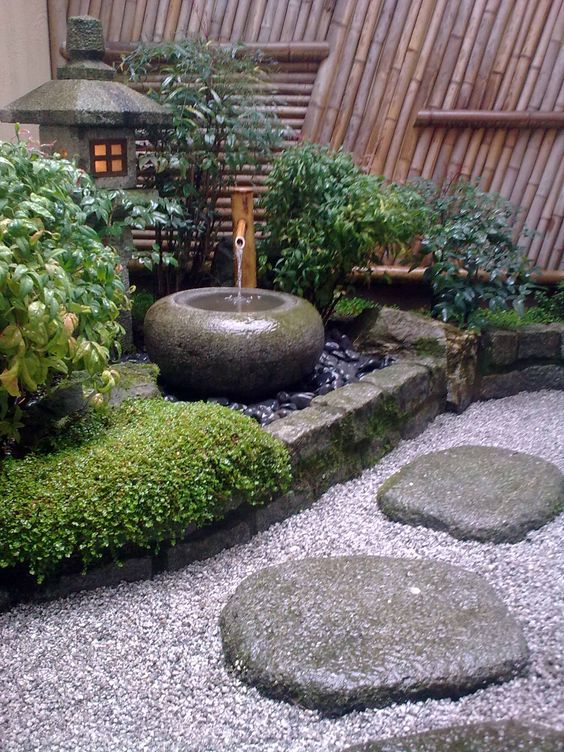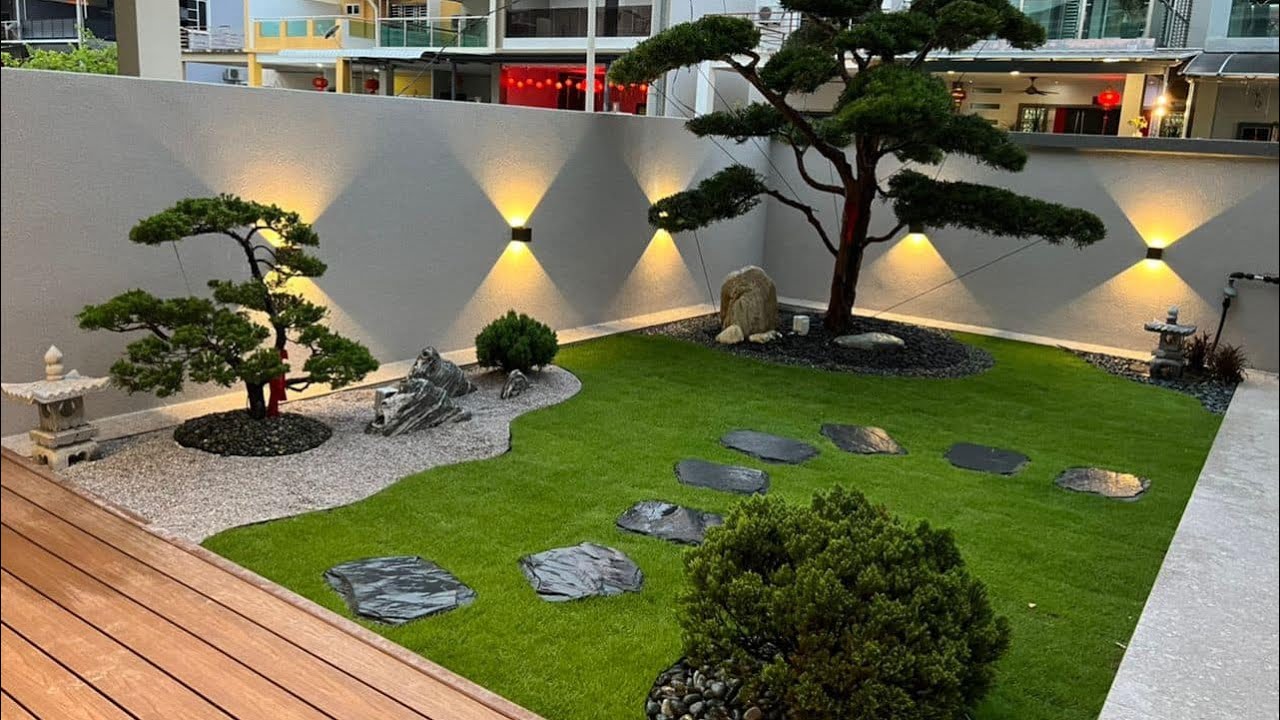A Japanese patio garden design creates a serene, minimalist space that emphasizes natural elements and harmony. Key features include stones, water, and plants.
Japanese patio gardens offer a tranquil retreat right in your backyard. These gardens focus on simplicity and balance, using natural elements to create a peaceful environment. Stones represent mountains, while water elements symbolize purity and calmness. Plants like bamboo, moss, and bonsai add texture and greenery, enhancing the garden’s aesthetic.
Pathways made of stepping stones guide you through the garden, inviting contemplation and relaxation. Lighting plays a crucial role, with lanterns adding a soft, ambient glow. This design encourages mindfulness and a deep connection with nature, making it a perfect sanctuary for meditation and relaxation.
Introduction To Japanese Patio Gardens
Japanese patio gardens offer tranquility and simplicity. They bring harmony to your outdoor space. These gardens blend nature with minimalist design principles.
The Allure Of Minimalist Design
Minimalist design is about simplicity. It uses clean lines and open spaces. Japanese gardens excel in this. They use few elements to create beauty. This makes your patio peaceful and uncluttered.
Key elements of minimalist design include:
- Rocks
- Sand
- Water features
- Simple plants
These elements are arranged thoughtfully. Each one has a purpose. The result is a serene and balanced space.
Incorporating Nature Into Your Outdoor Space
Nature is central to Japanese gardens. They mimic natural landscapes. You can bring this into your patio. Use plants like bamboo and moss. Add a small water feature, like a pond or fountain. This attracts birds and creates a soothing sound.
Here are some nature elements to include:
- Bamboo plants
- Stone lanterns
- A small pond
- Gravel paths
Create a natural sanctuary in your patio. Choose elements that blend with the surroundings. This enhances the feeling of being in nature. Your patio becomes a peaceful retreat.
Historical Roots Of Japanese Garden Aesthetics
Japanese patio gardens have a rich history. Their design reflects ancient cultural values. These gardens are more than just beautiful spaces. They embody deep philosophical ideas and historical influences.
Influence Of Zen Buddhism
Zen Buddhism has a profound impact on Japanese gardens. The principles of simplicity and tranquility are central. Gardens become places for meditation and reflection. Stones, water, and plants are used sparingly. Each element has a purpose and meaning.
Zen gardens often include gravel to represent water. The raked patterns symbolize waves. Rocks can signify mountains or islands. These elements create a sense of peace and balance.
Evolution From Ancient Traditions
Japanese gardens evolve from ancient traditions. Early gardens were influenced by Chinese landscape art. Over time, they developed unique characteristics. The Heian period saw the rise of the Shinden-zukuri style. This style featured large ponds and islands.
During the Kamakura and Muromachi periods, tea gardens and Zen gardens emerged. These gardens focused on simplicity and spiritual depth. The Edo period brought stroll gardens with winding paths. Each path offered different views and experiences.
Essential Elements Of Japanese Patio Design
Japanese patio gardens are serene spaces. They are designed with simplicity and natural beauty. Each element has a purpose and adds to the tranquility.
The Role Of Stones And Gravel
Stones and gravel play a vital role in Japanese patios. They symbolize strength and endurance. Stones come in various shapes and sizes. They are often used to create paths or focal points.
Gravel represents water in dry gardens. It is raked into patterns that mimic waves. This adds a calming effect. Here are common uses of stones and gravel:
- Pathways
- Zen gardens
- Decorative borders
Using stones and gravel enhances the garden’s natural feel. It also requires minimal maintenance.
Significance Of Water Features
Water features are essential in Japanese gardens. They symbolize life and renewal. The sound of water adds to the peaceful atmosphere.
Common water features include:
- Small ponds
- Waterfalls
- Bamboo water fountains
Each water feature has a unique sound and look. This makes the garden more dynamic. Water features attract wildlife, adding to the garden’s beauty.
Incorporating these elements creates a true Japanese patio garden. It brings peace and nature to your home.
Selecting Plants For Your Japanese Patio
Creating a Japanese patio garden requires thoughtful plant selection. The right plants provide year-round beauty. They also ensure harmony in your outdoor space.
Choosing Species For Year-round Appeal
Select plants that offer seasonal interest. This keeps your garden lively all year. Consider these options:
- Japanese Maple: Stunning autumn colors.
- Cherry Blossom: Beautiful spring blooms.
- Bamboo: Evergreen and soothing rustling sounds.
- Azalea: Vibrant spring flowers.
- Hosta: Lush summer foliage.
Use a mix of trees, shrubs, and ground covers. This ensures visual variety throughout the seasons.
| Plant | Season | Feature |
|---|---|---|
| Japanese Maple | Autumn | Colorful foliage |
| Cherry Blossom | Spring | Delicate flowers |
| Bamboo | All year | Evergreen |
| Azalea | Spring | Bright blooms |
| Hosta | Summer | Green leaves |
Pruning Techniques For Shape And Harmony
Pruning is crucial in a Japanese garden. It maintains the balance and harmony. Follow these tips:
- Thin branches to enhance air flow.
- Shape trees to highlight their natural form.
- Remove dead or diseased wood.
- Trim shrubs to create clean lines.
- Cut back perennials after blooming.
Use the right tools for clean cuts. This promotes healthy growth. Regular pruning keeps your garden neat and beautiful.
Architectural Features And Ornaments
Japanese patio gardens are known for their serene beauty. They use various architectural features and ornaments. These elements bring peace and harmony to the space.
Integrating Lanterns And Basins
Lanterns are a staple in Japanese gardens. They symbolize light in the darkness. They come in different shapes and sizes. Stone lanterns are the most common.
- Stone Lanterns: These are traditional and durable.
- Metal Lanterns: These provide a modern touch.
Basins are used for purification. They are placed near the entrance. Visitors wash their hands before entering the garden. This ritual cleanses the spirit.
| Type | Purpose |
|---|---|
| Lanterns | Light and decoration |
| Basins | Purification |
The Purpose Of Gates And Fences
Gates symbolize the transition from the outer world to the inner sanctuary. They mark the boundary of the garden. Gates can be simple or elaborate.
- Simple Gates: Made from wood, blending with nature.
- Elaborate Gates: Often decorated, showing craftsmanship.
Fences provide privacy and security. They also add to the garden’s aesthetics. Bamboo is a popular material for fences. It is both strong and beautiful.
| Material | Advantages |
|---|---|
| Wood | Natural look, blends well |
| Bamboo | Strong, beautiful |

Credit: www.pinterest.com
Creating A Sense Of Enclosure And Intimacy
A Japanese patio garden should feel enclosed and intimate. This design creates a peaceful retreat. The feeling of being enclosed brings comfort and solitude. It makes the garden a perfect space for meditation and relaxation.
Using Screens And Hedges
Screens and hedges create natural barriers. These elements are vital in a Japanese garden. Screens can be made of bamboo or wood. They add an aesthetic touch while providing privacy.
Hedges serve a similar purpose. They act as green walls that enclose your space. Choose plants that grow well in your climate. Trim them regularly to maintain a clean look.
Designing For Privacy And Tranquility
Privacy is essential for a tranquil garden. Use tall plants and structures to block unwanted views. Place them strategically around your patio.
Consider adding a water feature. The sound of flowing water enhances the sense of calm. A small pond or fountain works well.
Make pathways with stepping stones or gravel. These paths guide visitors through the garden. They also add to the peaceful atmosphere.
The Importance Of Pathways And Flow
Pathways are key in Japanese patio garden design. They guide visitors through the space. Proper flow ensures a serene experience. Each step should feel intentional and calming. Pathways connect garden elements, creating harmony.
Laying Out Stepping Stones
Stepping stones are both functional and beautiful. They help create a journey through the garden. Choose stones that match your garden’s theme. Spaces between stones should be consistent. This makes walking comfortable and safe. Use a variety of stone sizes for visual interest.
| Stone Type | Characteristics | Best Use |
|---|---|---|
| Granite | Durable and weather-resistant | Main pathways |
| Slate | Smooth and elegant | Decorative areas |
| Flagstone | Natural and rustic | Casual paths |
Guiding Movement Through The Garden
A well-designed path guides visitors effortlessly. Curved paths create a sense of mystery. Straight paths lead to focal points. Use plants and stones to highlight the path. Lanterns and statues can also mark important spots.
- Keep paths clear of debris.
- Use lighting for evening walks.
- Ensure paths connect all garden areas.
- Introduce variety with different textures.
Maintain the balance between openness and enclosure. This makes the garden inviting and intimate. Pathways should enhance the natural beauty of the space. They should never feel forced or out of place.
:strip_icc()/japanese-garden-pond-bd590f78-2e175d1664fb4a149010c6de81b01f5d.jpg)
Credit: www.bhg.com
Maintaining Your Japanese Patio Garden
Maintaining a Japanese patio garden ensures it remains beautiful and serene. Regular care can keep your garden looking perfect all year round.
Regular Upkeep For Lasting Beauty
Regular upkeep is essential for a Japanese patio garden. Trim the plants to keep them neat. Remove weeds to ensure a clean look. Water the plants regularly to keep them healthy. Check the soil to ensure it is moist but not soggy.
Using these simple steps can help maintain the garden:
- Check and maintain the water features weekly.
- Clean the pathways and remove debris.
- Prune the bonsai trees as needed.
- Use natural fertilizers for the plants.
Seasonal Considerations And Care
Different seasons require different care for your garden. Spring is the time to plant new flowers. Summer needs regular watering. Autumn involves removing fallen leaves. Winter requires protecting plants from frost.
| Season | Care Tips |
|---|---|
| Spring | Plant new flowers, prune old branches. |
| Summer | Water plants regularly, check for pests. |
| Autumn | Remove fallen leaves, prepare for winter. |
| Winter | Protect plants from frost, reduce watering. |
Following these steps ensures your Japanese patio garden thrives all year.
Case Studies: Successful Japanese Patio Gardens
Japanese patio gardens can transform spaces into serene havens. They blend nature and design seamlessly. Here are some inspiring case studies of successful Japanese patio gardens.
Urban Spaces Transformed
Many cities have limited outdoor space. Urban dwellers crave nature. A small Japanese garden can bring tranquility to city life.
- Location: Shibuya, Tokyo
- Size: 10 square meters
- Features: Zen stone garden, bamboo fence, water basin
This tiny balcony became a peaceful retreat. The Zen stone garden includes smooth pebbles and a small Buddha statue. The bamboo fence adds privacy and a natural feel. A water basin provides a calming sound.
- Location: Manhattan, New York
- Size: 30 square meters
- Features: Koi pond, wooden deck, rock garden
This rooftop garden offers a serene escape. The koi pond adds life and movement. The wooden deck is perfect for meditation. The rock garden features carefully placed stones and raked gravel.
Bringing Japanese Design To Different Climates
Japanese garden design can adapt to various climates. Here are examples from different regions.
- Location: Phoenix, Arizona
- Size: 20 square meters
- Features: Succulents, sand garden, shaded seating
This garden uses drought-tolerant plants. Succulents replace traditional moss. The sand garden mimics a Zen garden’s simplicity. A shaded seating area offers respite from the sun.
- Location: Miami, Florida
- Size: 25 square meters
- Features: Bamboo grove, water feature, flowering plants
This tropical garden blends Japanese design with local flora. A bamboo grove provides a lush backdrop. The water feature includes a small waterfall and pond. Flowering plants add color and vibrancy.
| Location | Size | Key Features |
|---|---|---|
| Shibuya, Tokyo | 10 sq meters | Zen stone garden, bamboo fence, water basin |
| Manhattan, New York | 30 sq meters | Koi pond, wooden deck, rock garden |
| Phoenix, Arizona | 20 sq meters | Succulents, sand garden, shaded seating |
| Miami, Florida | 25 sq meters | Bamboo grove, water feature, flowering plants |
Conclusion: Harmony With Nature
Creating a Japanese patio garden offers a deep connection with nature. The design focuses on balance, simplicity, and tranquility. This section delves into the harmony achieved and how to continue the garden design journey.
Reflecting On The Tranquility Achieved
A Japanese patio garden brings peace and serenity. It uses natural elements like rocks, water, and plants. These elements create a calming atmosphere. The garden invites quiet reflection and meditation.
Key features of the Japanese patio garden include:
- Rocks: Represent mountains and strength.
- Water: Symbolizes life and renewal.
- Plants: Show growth and change.
- Pathways: Guide the visitor through the garden.
The careful arrangement of these elements is crucial. Each element complements the others, creating a peaceful space. The garden reflects the beauty of nature in every detail.
Continuing The Journey Of Garden Design
Maintaining a Japanese patio garden requires ongoing care. Regular pruning keeps plants healthy and neat. Clean pathways and water features regularly. This ensures the garden remains inviting and serene.
Consider adding seasonal plants to the garden. They bring new colors and textures throughout the year. This keeps the garden dynamic and engaging.
Here are some tips for ongoing garden care:
- Water plants regularly but avoid overwatering.
- Trim plants to maintain their shape.
- Remove weeds to keep the garden tidy.
- Check water features to ensure they work properly.
Continuing the journey of Japanese garden design brings lasting peace and joy. Each step deepens the connection with nature.

Credit: tamatelandscaping.com
Frequently Asked Questions
What Are The Three Essential Elements Of A Japanese Garden?
The three essential elements of a Japanese garden are water, rocks, and plants. Water symbolizes life, rocks represent strength, and plants provide beauty and tranquility.
What Is A Traditional Japanese Garden Layout?
A traditional Japanese garden layout features natural elements like rocks, water, plants, and bridges. It emphasizes simplicity and harmony.
How To Design A Japanese Garden For Beginners?
Start with a simple layout using rocks, water features, and plants. Choose Japanese maples, moss, and bamboo. Add a gravel pathway. Maintain balance and harmony. Keep it minimalistic and serene.
What Are The Three Types Of Japanese Gardens?
The three types of Japanese gardens are Karesansui (rock gardens), Tsukiyama (hill gardens), and Chaniwa (tea gardens). Each type offers unique aesthetics and purposes, reflecting Japanese culture and philosophy.
Conclusion
Creating a Japanese patio garden brings tranquility and beauty to your outdoor space. With thoughtful design elements, you can achieve a serene atmosphere. Incorporate natural materials, water features, and minimalist plants to enhance the peaceful ambiance. Embrace the simplicity and harmony of Japanese garden design for a relaxing retreat at home.

